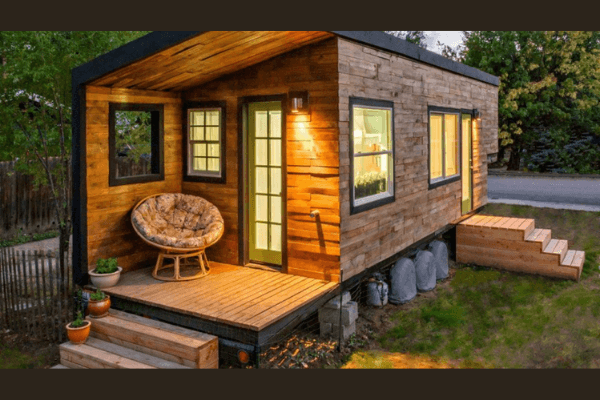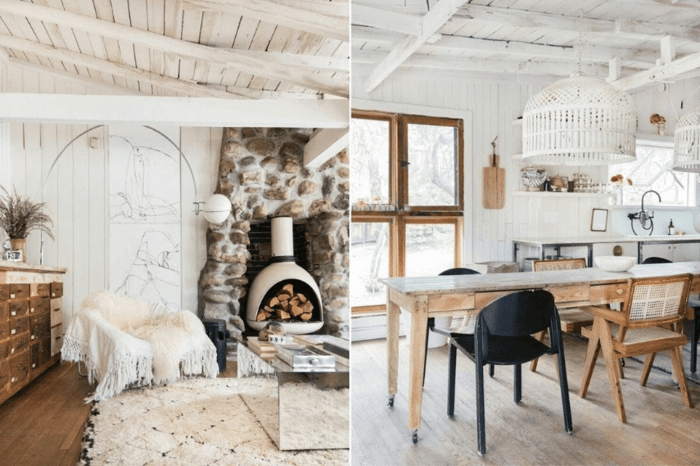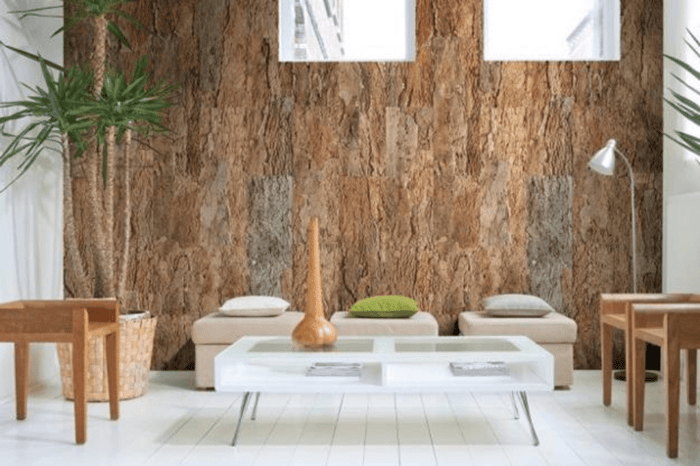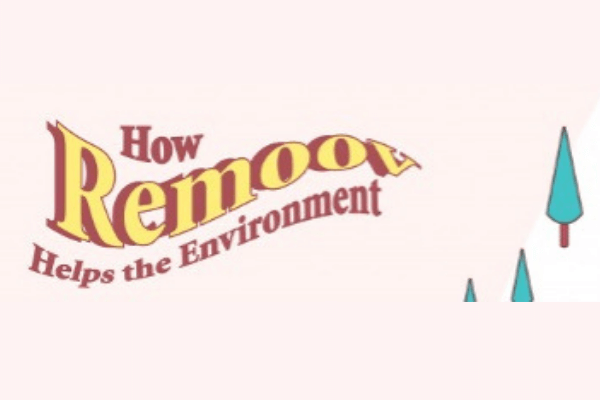Changes in the world economy, shortage of supplies, and more consciousness about environmental changes have brought sustainability, the economy of use, and deeper awareness of how to spend a dollar to the forefront of everyone’s mind. Thankfully with eco-friendly and mindful ways of living taking more space center stage, the boom in the tiny home world is heavily trending. These space-saving, economical, and sustainable living options make the least impact on our planet. This is part of society’s shift over to a less materialistic mindset. The boom has also increased as travelers seek safe, remote, and compact havens during times like the pandemic.
Definition: While there is no official definition of a tiny house, it is generally thought of as a small house, typically sized under 600 square feet. While they can be built on foundations, most tiny homes are built on moveable bases (such as a trailer).

TIPS TO SUPPORT AN ECO-FRIENDLY TINY HOME
While most small homes are actually designed as eco-friendly right off the bat, there are some guidelines you can follow to outfit and decorate your tiny home with the best eco-conscious practices in mind.
- Install solar panels.
- Use a composting toilet.
- Establish an on-demand heated water supply, powered by the trailer.
 Use Natural Energy: Solar & More
Use Natural Energy: Solar & More
Using natural energy is number one in environmental friendliness. It can also save you cash in the long run.
- Solar panels are a natural energy source.
- Solar panels convert the sun’s light into energy which can be used to power lights and other electronically based things in your home.
- This will cut your electric bill down significantly while also not using electricity as a power source.
- Natural energy can also mean using your natural light thru windows efficiently.
- Natural light means less use of electricity, ultimately making a positive impact on the environment.
 Heating & Cooling System Awareness
Heating & Cooling System Awareness
- Since tiny homes already require less energy than standard homes you’re saving money and environmental impact at the start. But how can you save even more?
- Put a timer on your heating and cooling systems.
- A smart thermostat is another savvy option to limit the use of either of these systems.
- For heating needs, individual electric heaters use less energy than an entire home heating system.
- For cooling down the space, open windows when possible, and use floor fans.
 Sustainable Flooring
Sustainable Flooring
For an eco-friendly flooring choice, consider cork which is made from recycled corks. Additional benefits include:
- It is hypoallergenic.
- Completely water-resistant.
- Provides great insulation.
- Is giving (unlike tile) and comfortable to stand on for long periods of time thus reducing foot or back pain.
 Recycled Glass Tiles
Recycled Glass Tiles
Sometimes on the more pricey side, using recycled glass tile in a tiny home is doable since there will be less space to cover. This eco-friendly material has other benefits as well:
- Recycled glass tile is VOC (volatile organic compounds) free which means you won’t experience any toxic off-gassing from these materials.
- Can be used in a bathroom, the kitchen, or as a floor covering.
- Another constructive way to upcycle materials and keep them out of landfills.
 GREEN DECORATING YOUR TINY HOME
GREEN DECORATING YOUR TINY HOME
Part of a tiny home mindset is usually right in alliance with a green or eco-friendly mindset as well; living a life of simplicity, efficiency, and eco-awareness. These tips will help you remain organic in your approach and affordable in price. And there’s no need to give up on style just cause you’re going small. You can also make your tiny home look absolutely stunning.
Declutter: The Zen Zone
The first step in your decorating process for a tiny home is to organize and declutter. You just don’t have the space to accumulate mess or horde items.
- Slim down your belongings as much as possible.
- Smart storage space is a must; utilize areas like under the stairs or vertical space in the form of shelving.
- A cleaner organized home is more relaxing.
 Color
Color
This guide will explain all the ways you can use color and how to make the appropriate choice for your space. But the general rules are dark colors make a space look smaller while lighter colors open up a space and make it appear larger.
- For small spaces, it is generally better to use neutral tones as an overall base.
- Add pops of bright colors in smaller accessories or on an accent wall.
- Light tones give the illusion of a bigger, airy space.
- Except for the ceiling: a darker ceiling is a designer’s secret to making a ceiling appear higher than it is.
- To keep it ‘green’, here are about a dozen of the best eco-friendly paint brands on the market today.
 Lighting: Go Eco-Friendly With Energy-Wise Options
Lighting: Go Eco-Friendly With Energy-Wise Options
Lighting can literally make or break the entire look and feel of a room. Thankfully, lighting design is one of the more affordable areas in which to make a green difference.
- Always make the most of natural light options first.
- Second, opt for energy-efficient fixtures.
- Eco interior design incorporates smart glass, larger windows, and skylights where possible.
- Lighter-colored decor schemes lessen the need for manufactured lighting.
- LEDs or composite fluorescent bulbs last longer and lower energy consumption
 Eco Collapsible Furniture
Eco Collapsible Furniture
Clever furniture ideal for small spaces is exactly what you want to be looking for to furnish your tiny home.
- A corner desk with vertical shelving.
- Or a foldable workspace with included storage.
- Flexible furniture with snap-together frames.
- Look for eco-friendly materials to minimize your carbon footprint.
- If on a budget, look for things you can upcycle to turn into fun and unique pieces of tiny house furniture and appliances.
 Loft Beds: Smart Use of Space
Loft Beds: Smart Use of Space
Loft-style beds are private cozy corners that call for weekends of snuggling.
- Using a frame with plenty of storage underneath is ideal.
- If your loft area is tight, there are special eco-sheets that are made with zippers around the corners so changing the bed is not a frustrating endeavor.
 Bed Headboard: Eco-Friendly & Stylish
Bed Headboard: Eco-Friendly & Stylish
Maybe you only have space for an air mattress in your tiny home. Whatever the circumstance, adding a headboard is a small space taker and big style maker.
- Reclaimed wood, old doors, pallets, and many other materials can be upcycled to make a stylish headboard for your tiny home bedroom.
- One with storage included is even better for use in small spaces.
 Built-In Storage: Best For Organization
Built-In Storage: Best For Organization
In small spaces, we’re always looking to get the most out of every item of furniture. So chairs, stools, sofas, beds… any item with build-in storage is ideal to keep your tiny home organized.
- Keeping with the eco-friendly them means looking for custom-built pieces from local crafts-people.
- Pisces that use upcycled or reclaimed materials.
- The same goes for finishes, using eco-friendly stains, paints, and other such type of final coverings.
 Mirrors: Wonders of Decor & Buy Pre-Loved To Stay Green
Mirrors: Wonders of Decor & Buy Pre-Loved To Stay Green
Mirrors are excellent decor accents because they can manipulate space in so many positive ways. Since a tiny home by definition is small, using appropriately placed mirrors gives you the advantage of opening space and creating the look of larger rooms.
- Mirrors come in all shapes and with frames in all styles. Thus they are extremely versatile for use in any decor design choice.
- Décor items like bowls and vases with an embedded mirror design make great accents in tiny homes too.
- Source from your local secondhand shops to follow an environmentally sustainable choice.
 Decorate with Plants
Decorate with Plants
An almost free, lovely, and perfect way to decorate your tiny home in an eco-friendly manner, adorn it with a variety of plants.
- Bonus: plants remove toxins from the air.
- Plants are small and don’t take up a lot of room, making them a great addition to your tiny home.
 Art!
Art!
Art accents are the completely personal way to decorate your space and let your creativity and personal style shine.
- Art is a way to share your personal sense of style.
- Plus it can be 100% eco-friendly by using upcycled sculptures, art made from reclaimed materials, or second-hand purchased art pieces.
- Options can include framing photographs, posters, paintings, or fabric décor pieces.
- The addition of molding is another artistic way to instantly lift the feel of a space and make it feel more glamourous.
 Outdoor Space
Outdoor Space
The flow of life to outdoor living areas is especially important around tiny homes to give you additional space to work, play, hangout and relax.
- Eco-friendly outdoor furniture uses much of the same applications as indoor items.
- Meaning, invest in pre-loved pieces, use rescued and reclaimed materials, and upcycle items into different uses.
 ECO-FRIENDLY TINY HOME OPTIONS
ECO-FRIENDLY TINY HOME OPTIONS
Shipping Containers
A used shipping container ranges from $3,000-5,000, so they are a quite affordable small housing option. They can be outfitted with all manner of sustainable options from solar panels, to no VOC materials, eco lighting, etc.
Reclaimed Tin & Cedar- These tiny homes uses reclaimed corrugated tin and cedar boards prominently as siding. Inside portions of the home use old barn wood.

Put Shipping Pallets To Use- Utilize shipping pallets for siding and reclaimed windows.

Some tiny natural homes are built out of cob, which is a mixture of sand, straw, and clay.

#tinyhome #tinyhouse #tinyliving #tinyhousemovement #vanlife #tinyhomes #tinyhousenation #diy #homeiswhereyouparkit #tinyhouseonwheels #tinyhouselife #tinyhouseliving #tinyhouses #offgridliving #tinyhousedesign #cabinlife #architecture #camping #homeonwheels #skoolie #tinyhousebuild #buslife #tinyhomeonwheels #travel #cabin #cabinporn #tinyhouselove #interiordesign #cabinliving #smallhome #smallhouse #smallhomes #tinyhomes #interiordesign #littlehouse #tinyhouselove #homedecor #house #tinyhousemovement #design #tinyhousenation #tinyhouselife #homedesign #littlehome #tinyhousejam #tinyhouseonwheels #littlehouses #tinyhousecommunity #offgrid #tinylife #tinyhousejamboree #tinylifestyle #decor








